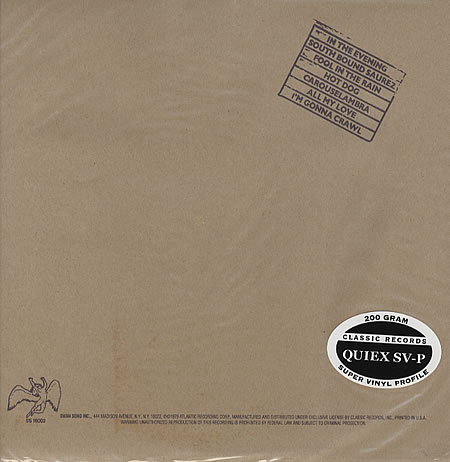

Released 15 August 1979
Recorded November–December 1978, Polar Studios, Stockholm, Stockholm County, Sweden
Singles from In Through the Out Door
1. "Fool in the Rain/Hot Dog"
Released: 7 December 1979
Background
The album was named by the group to describe its recent struggles amidst the death of Robert Plant's son Karac in 1977, and the taxation exile the band took from the UK as a result of the Harold Wilson and James Callaghan administrations, which also adversely affected other major British bands of the time, such as The Rolling Stones. The exile resulted in the band being unable to tour on British soil for over two years, and trying to get back into the public mind was therefore like "trying to get in through the 'out' door."
In contrast to previous Led Zeppelin albums, In Through the Out Door features much greater influence on the part of bassist and keyboardist John Paul Jones and vocalist Robert Plant, and relatively less from drummer John Bonham and guitarist Jimmy Page. Two songs from the album—"South Bound Saurez" and "All My Love"—were the only two original Led Zeppelin songs which Jimmy Page had no part in writing. With the exception of "Darlene," a Boogie-Woogie based song credited to all band members (which was eventually released on the 1982 album, Coda), Bonham did not receive writing credits for any of the songs recorded at Polar Studios. This diminished input by Page and Bonham is attributed to the two band members often not showing up on time at the recording studio, with Bonham struggling with alcoholism and Page battling heroin addiction. As Jones said: "There were two distinct camps by then, and we [myself and Plant] were in the relatively clean one."
Many of the songs were consequently put together by Plant and Jones during the day, with Page and Bonham adding their parts late at night. According to Jones, this was "mainly because I had a new toy. I had this big new keyboard. And Robert and I just got to rehearsals early, basically... So Robert and I, by the time everybody turned up for rehearsals, we’d written three or four songs. So we started rehearsing those immediately, because they were something to be getting on with."
Both Page and Bonham later expressed reservations about the album. In an interview he gave to Guitar World magazine in 1998, Page stated that he and Bonham:
... both felt that In Through the Out Door was a little soft. I wasn't really keen on "All My Love". I was a little worried about the chorus. I could just imagine people doing the wave and all of that. And I thought, that's not us. That's not us. In its place it was fine, but I wouldn't have wanted to pursue that direction in the future.
Years later, Page elaborated that "we wanted, after In Through the Out Door, to make something hard-hitting and riff-based again. Of course, we never got to make that album." He is also quoted as saying "It wasn't the most comfortable album. I think it was very transitional... a springboard for what could have been.
Following the recording sessions at Polar Studios, the album was mixed at Page's personal studio at his home in Plumpton, "Wearing and Tearing", "Ozone Baby" and "Darlene" were recorded during sessions for this album, but were dropped due to space constraints.
All later appeared on Coda.
Album sleeve design
The original album featured an unusual gimmick: the album had an outer sleeve which was made to look like a plain brown paper bag, and the inner sleeve featured black and white line artwork which, if washed with water, would become permanently fully colored. There were also six different sleeves featuring a different pair of photos (one on each side; see images at right), and the external brown paper sleeve meant that it was impossible for record buyers to tell which sleeve they were getting. (There is actually a code on the spine of the album jacket, which indicated which sleeve it was—this could sometimes be seen while the record was still sealed.) The pictures all depicted the same scene in a bar (in which a man burns a Dear John letter), and each photo was taken from the separate point of view of someone who appeared in the other photos.
The album artwork was designed by Hipgnosis. Storm Thorgerson recalls the design in his book Eye of the Storm:
The sepia quality was meant to evoke a non-specific past and to allow the brushstroke across the middle to be better rendered in colour and so make a contrast. This self same brushstroke was like the swish of a wiper across a wet windscreen, like a lick of fresh paint across a faded surface, a new look to an old scene, which was what Led Zeppelin told us about their album. A lick of fresh paint, as per Led Zeppelin, and the music on this album... It somehow grew in proportion and became six viewpoints of the same man in the bar, seen by the six other characters. Six different versions of the same image and six different covers.
* Barry Diament – mastering (original Compact Disc release)
* Peter Grant – executive producer
* Hipgnosis – record sleeve
* Leif Mases – engineering
* George Marino – remastered Compact Disc release
* Lennart Östlund – assistant engineering